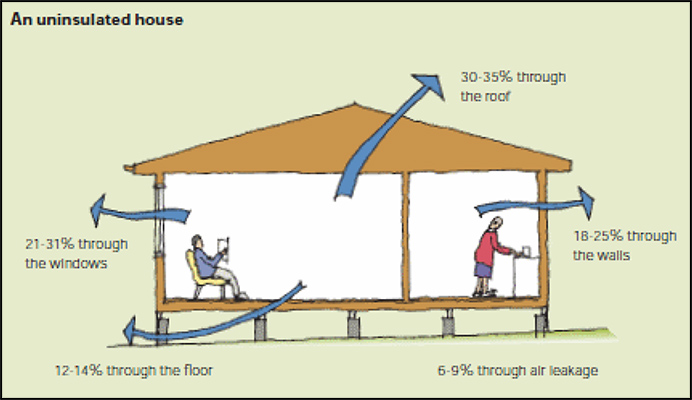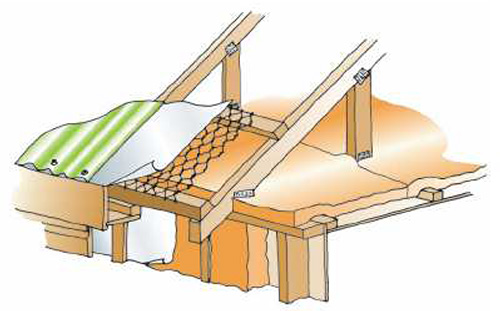Insulation basics
Most New Zealand homes are under-insulated, and even the current building code does not require the high levels of Insulation required by other countries.
- Insulation creates a barrier that slows the transfer of heat from the inside of your house to outside. It is the most effective way to keep your house warm.
- A well-insulated house requires less heating (or cooling) to maintain a given temperature.
- Many houses were built before insulation was widely used or made compulsory in 1978.
- Insulation levels required by the NZ Building Code are decades behind European levels.
In this information sheet you will find tips on how to insulate your home and make your insulation dollar go as far as possible.
In a nutshell
Two-thirds of current New Zealand homes were built before 1978 when it became mandatory to install insulation.
This means two-thirds were built with hollow walls clad with weatherboards, bricks or sheeting, single-glazed wooden-framed windows and generally wooden floors over piles. Making a pretty leaky house that is hard to heat. Insulation can go a long way to keeping your home warm and your power bills down. It makes for a healthier environment, reducing colds and other respiratory illnesses by helping to eliminate condensation, dampness and mould.

Heat loss in a house – BRANZ
Where your heat goes: If your house has no insulation, about a third of heat is lost through the roof, another third disappears through windows, with the final third vanishing through the floor, the walls and through air leakage.
Ceiling
The ceiling space should be your first area to insulate – it is the easiest, most accessible area of your house to insulate and gives the biggest bang for your buck! Even if you have some insulation in your ceiling it is worth checking it is still performing. If it is an older type of insulation it is likely it has settled and is performing to a much lower standard to what we would do today. The best way to insulate accessible ceilings is with one layer between the joists and a second layer perpendicular and over the joists with blanket insulation.
 Blanket insulation in the ceiling
Blanket insulation in the ceiling
NZS4246: 2006 Energy Efficiency – Installing Insulation in
Residential Buildings
Note that recessed ceiling downlights are a source of heat loss – air moves through gaps around the bulb, and insulation must be kept well clear of them due to the risk of fire, unless they are specially rated. Ideally downlights should be replaced with a ceiling light or they can be swapped out with LED (Light Emitting Diode) downlights rated to be abutted and covered with insulation
Floors and walls
Floors are relatively easy to insulate, provided there is reasonable access. Between 12% and 14% of heat loss is through the floor. Gaps in floors leak heat. Even small gaps can have a big effect. Installing your own underfloor insulation is possible, though not always advisable, because electrical cabling is sometimes laid between floor joists. For a long time, foil was the most common type of underfloor insulation. Due to the risk of electrocution retrofitting or repairing foil is now banned under the Building Act.
At the same time as installing insulation it is worth installing polythene on the ground as a moisture barrier. Even ground that feels dry about 40L per day of water can be released from the ground under a 100m2 house.
Insulating existing walls is difficult due to the internal lining or external cladding having to be removed first. If renovating, the method that we strongly recommend is removing the old wall linings and installing insulation. Also replace the building paper if missing – see detail in NZS4246. Target south-facing walls, which do not get sun and may also be hit by cold winds.
Please note that a Building Consent is required for work involving wall insulation due to bracing and weather-tightness issues that may result. Talk to a qualified builder or building officer for more information.
Draughts
Uncontrolled draughts can lead to considerable heat loss. Sealing up most draughts can be easy and inexpensive.
- Fit self-adhesive weather strips around windows and strips and draught excluders around and under external doors.
- Seal up openings such as unused cat doors and open fireplaces.
- Get some draught ‘sausages’ to lie against the bottom of doors.
Product Options
If possible always insulate to a higher level than the New Zealand Building Code. It is a minimum. The extra cost in Insulation will mean lower power bills and greater comfort and most importantly improved health of the occupants. R-value refers to the resistance of the insulation, therefore the higher the R-value the more heat it stops from escaping. Choose a product that both suits your needs and has as high as R-value as possible.
Your choice of insulation types includes insulation installed as a blanket, segments or loose fill. It depends on where you use the product to what type is most suitable for the situation, eg segments for your walls that fit between the studs. There are also different materials, such as polyester, fiberglass, wool etc. Before deciding on an insulation product here are some points to consider:
- Does it lose effectiveness if it gets damp?
- Will it eventually ‘settle’, that is, slowly collapse, and become less effective?
- Is exposure to it hazardous to your health?
- Has an independent body such as BRANZ appraised or endorsed it?
- Is it recyclable or biodegradable in a landfill?
- Is there a guarantee?
- What is the expected lifespan?
Quality installation of insulation is important in all areas of your house – a gap of 5% can result in a 50% loss of the potential insulation effect in the immediate area of the gap.
Subsidies
Subsidies are available through the Warmer Kiwi Homes scheme (see energywise.govt.nz). Please check with your local Eco Design Advisor for any other subsidies or loans available in your area.
For further information
Contact your nearest Eco Design Advisor
Visit our website ecodesignadvisor.org.nz
View helpful resources at:
Download PDF
